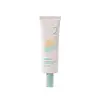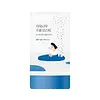What's inside
What's inside
 Key Ingredients
Key Ingredients

 Benefits
Benefits

 Concerns
Concerns

 Ingredients Side-by-side
Ingredients Side-by-side

Water
Skin ConditioningCyclopentasiloxane
EmollientCI 77891
Cosmetic ColorantEthylhexyl Methoxycinnamate
UV AbsorberDimethicone
EmollientZinc Oxide
Cosmetic ColorantEthylhexyl Salicylate
UV AbsorberGlycerin
HumectantTrimethylsiloxysilicate
EmollientCaprylyl Methicone
Skin ConditioningPEG-10 Dimethicone
Skin ConditioningButylene Glycol
HumectantPolyphenylsilsesquioxane
Dicaprylyl Carbonate
EmollientPentylene Glycol
Skin Conditioning1,2-Hexanediol
Skin ConditioningFusidium Coccineum Ferment Filtrate
Skin ConditioningCandida Bombicola/Glucose/Methyl Rapeseedate Ferment
AntimicrobialCentella Asiatica Extract
CleansingArtemisia Capillaris Extract
Melaleuca Alternifolia Leaf Extract
PerfumingMorinda Citrifolia Extract
AstringentHelianthus Annuus Seed Oil
EmollientCentella Asiatica Leaf Extract
Skin ConditioningHouttuynia Cordata Extract
Skin ConditioningDipropylene Glycol
HumectantAsiaticoside
AntioxidantAsiatic Acid
Skin ConditioningMadecassic Acid
Skin ConditioningMadecassoside
AntioxidantTocopherol
AntioxidantChlorella Vulgaris Extract
Skin ConditioningDisteardimonium Hectorite
StabilisingPolybutene
Polyhydroxystearic Acid
EmulsifyingAcrylates/Dimethicone Copolymer
Skin ConditioningDimethicone/Vinyl Dimethicone Crosspolymer
Skin ConditioningTribehenin
EmollientCaprylic/Capric/Myristic/Stearic Triglyceride
EmollientGlyceryl Tribehenate/Isostearate/Eicosandioate
EmollientMagnesium Sulfate
Aluminum Hydroxide
EmollientHydrogenated Coco-Glycerides
EmollientStearic Acid
CleansingGlucose
HumectantEthylcellulose
Fructooligosaccharides
HumectantFructose
HumectantVinyl Dimethicone/Methicone Silsesquioxane Crosspolymer
Triethoxycaprylylsilane
Ethylhexylglycerin
Skin ConditioningTrisodium Ethylenediamine Disuccinate
Hydrogenated Castor Oil Isostearate
Skin ConditioningPropanediol
SolventPolyvinyl Alcohol
Mica
Cosmetic ColorantCI 77491
Cosmetic ColorantCI 77288
Cosmetic ColorantCI 77492
Cosmetic ColorantCI 77499
Cosmetic ColorantCetyl PEG/PPG-10/1 Dimethicone
EmulsifyingWater, Cyclopentasiloxane, CI 77891, Ethylhexyl Methoxycinnamate, Dimethicone, Zinc Oxide, Ethylhexyl Salicylate, Glycerin, Trimethylsiloxysilicate, Caprylyl Methicone, PEG-10 Dimethicone, Butylene Glycol, Polyphenylsilsesquioxane, Dicaprylyl Carbonate, Pentylene Glycol, 1,2-Hexanediol, Fusidium Coccineum Ferment Filtrate, Candida Bombicola/Glucose/Methyl Rapeseedate Ferment, Centella Asiatica Extract, Artemisia Capillaris Extract, Melaleuca Alternifolia Leaf Extract, Morinda Citrifolia Extract, Helianthus Annuus Seed Oil, Centella Asiatica Leaf Extract, Houttuynia Cordata Extract, Dipropylene Glycol, Asiaticoside, Asiatic Acid, Madecassic Acid, Madecassoside, Tocopherol, Chlorella Vulgaris Extract, Disteardimonium Hectorite, Polybutene, Polyhydroxystearic Acid, Acrylates/Dimethicone Copolymer, Dimethicone/Vinyl Dimethicone Crosspolymer, Tribehenin, Caprylic/Capric/Myristic/Stearic Triglyceride, Glyceryl Tribehenate/Isostearate/Eicosandioate, Magnesium Sulfate, Aluminum Hydroxide, Hydrogenated Coco-Glycerides, Stearic Acid, Glucose, Ethylcellulose, Fructooligosaccharides, Fructose, Vinyl Dimethicone/Methicone Silsesquioxane Crosspolymer, Triethoxycaprylylsilane, Ethylhexylglycerin, Trisodium Ethylenediamine Disuccinate, Hydrogenated Castor Oil Isostearate, Propanediol, Polyvinyl Alcohol, Mica, CI 77491, CI 77288, CI 77492, CI 77499, Cetyl PEG/PPG-10/1 Dimethicone
Water
Skin ConditioningCoco-Caprylate/Caprate
EmollientDibutyl Adipate
EmollientSynthetic Wax
AbrasiveButyloctyl Salicylate
Skin ConditioningDiethylamino Hydroxybenzoyl Hexyl Benzoate
UV FilterVinyl Dimethicone/Methicone Silsesquioxane Crosspolymer
Butylene Glycol
HumectantEthylhexyl Triazone
UV AbsorberOzokerite
Emulsion StabilisingNiacinamide
SmoothingVinyldimethicone
Polysilicone-15
UV FilterBis-Ethylhexyloxyphenol Methoxyphenyl Triazine
Skin ConditioningBetula Platyphylla Japonica Juice
Skin ConditioningGlyceryl Glucoside
HumectantGlycerin
HumectantLaminaria Japonica Extract
Skin ProtectingUlmus Davidiana Root Extract
Skin ConditioningAloe Barbadensis Leaf Extract
EmollientViola Mandshurica Flower Extract
AntioxidantDioscorea Japonica Root Extract
Skin ConditioningHyaluronic Acid
HumectantAscorbic Acid
AntioxidantSodium Hyaluronate
HumectantPortulaca Oleracea Extract
Skin ConditioningDipotassium Glycyrrhizate
HumectantAllantoin
Skin ConditioningNonapeptide-1
Skin ConditioningDipeptide Diaminobutyroyl Benzylamide Diacetate
Skin ConditioningAcetyl Hexapeptide-8
HumectantCopper Tripeptide-1
Skin ConditioningTripeptide-1
Skin ConditioningPalmitoyl Tetrapeptide-7
Skin ConditioningPalmitoyl Tripeptide-1
Skin ConditioningPalmitoyl Tripeptide-5
Skin ConditioningPalmitoyl Pentapeptide-4
Skin ConditioningPalmitoyl Hexapeptide-12
Skin ConditioningPentapeptide-3
Skin ConditioningHexapeptide-9
Skin ConditioningAdenosine
Skin ConditioningEthylhexylglycerin
Skin ConditioningPolyglyceryl-5 Polyricinoleate
EmulsifyingGlyceryl Caprylate
EmollientCaprylyl Glycol
EmollientOryza Sativa Bran Oil
EmollientLauryl Polyglyceryl-3 Polydimethylsiloxyethyl Dimethicone
Skin ConditioningPolyglyceryl-4 Diisostearate/Polyhydroxystearate/Sebacate
EmulsifyingSodium Chloride
Masking1,2-Hexanediol
Skin ConditioningTocopherol
AntioxidantWater, Coco-Caprylate/Caprate, Dibutyl Adipate, Synthetic Wax, Butyloctyl Salicylate, Diethylamino Hydroxybenzoyl Hexyl Benzoate, Vinyl Dimethicone/Methicone Silsesquioxane Crosspolymer, Butylene Glycol, Ethylhexyl Triazone, Ozokerite, Niacinamide, Vinyldimethicone, Polysilicone-15, Bis-Ethylhexyloxyphenol Methoxyphenyl Triazine, Betula Platyphylla Japonica Juice, Glyceryl Glucoside, Glycerin, Laminaria Japonica Extract, Ulmus Davidiana Root Extract, Aloe Barbadensis Leaf Extract, Viola Mandshurica Flower Extract, Dioscorea Japonica Root Extract, Hyaluronic Acid, Ascorbic Acid, Sodium Hyaluronate, Portulaca Oleracea Extract, Dipotassium Glycyrrhizate, Allantoin, Nonapeptide-1, Dipeptide Diaminobutyroyl Benzylamide Diacetate, Acetyl Hexapeptide-8, Copper Tripeptide-1, Tripeptide-1, Palmitoyl Tetrapeptide-7, Palmitoyl Tripeptide-1, Palmitoyl Tripeptide-5, Palmitoyl Pentapeptide-4, Palmitoyl Hexapeptide-12, Pentapeptide-3, Hexapeptide-9, Adenosine, Ethylhexylglycerin, Polyglyceryl-5 Polyricinoleate, Glyceryl Caprylate, Caprylyl Glycol, Oryza Sativa Bran Oil, Lauryl Polyglyceryl-3 Polydimethylsiloxyethyl Dimethicone, Polyglyceryl-4 Diisostearate/Polyhydroxystearate/Sebacate, Sodium Chloride, 1,2-Hexanediol, Tocopherol
 Reviews
Reviews

Ingredients Explained
These ingredients are found in both products.
Ingredients higher up in an ingredient list are typically present in a larger amount.
1,2-Hexanediol is a synthetic liquid and another multi-functional powerhouse.
It is a:
- Humectant, drawing moisture into the skin
- Emollient, helping to soften skin
- Solvent, dispersing and stabilizing formulas
- Preservative booster, enhancing the antimicrobial activity of other preservatives
Butylene Glycol (or BG) is used within cosmetic products for a few different reasons:
Overall, Butylene Glycol is a safe and well-rounded ingredient that works well with other ingredients.
Though this ingredient works well with most skin types, some people with sensitive skin may experience a reaction such as allergic rashes, closed comedones, or itchiness.
Learn more about Butylene GlycolEthylhexylglycerin (we can't pronounce this either) is commonly used as a preservative and skin softener. It is derived from glyceryl.
You might see Ethylhexylglycerin often paired with other preservatives such as phenoxyethanol. Ethylhexylglycerin has been found to increase the effectiveness of these other preservatives.
Glycerin is already naturally found in your skin. It helps moisturize and protect your skin.
A study from 2016 found glycerin to be more effective as a humectant than AHAs and hyaluronic acid.
As a humectant, it helps the skin stay hydrated by pulling moisture to your skin. The low molecular weight of glycerin allows it to pull moisture into the deeper layers of your skin.
Hydrated skin improves your skin barrier; Your skin barrier helps protect against irritants and bacteria.
Glycerin has also been found to have antimicrobial and antiviral properties. Due to these properties, glycerin is often used in wound and burn treatments.
In cosmetics, glycerin is usually derived from plants such as soybean or palm. However, it can also be sourced from animals, such as tallow or animal fat.
This ingredient is organic, colorless, odorless, and non-toxic.
Glycerin is the name for this ingredient in American English. British English uses Glycerol/Glycerine.
Learn more about GlycerinTocopherol (also known as Vitamin E) is a common antioxidant used to help protect the skin from free-radicals and strengthen the skin barrier. It's also fat soluble - this means our skin is great at absorbing it.
Vitamin E also helps keep your natural skin lipids healthy. Your lipid skin barrier naturally consists of lipids, ceramides, and fatty acids. Vitamin E offers extra protection for your skin’s lipid barrier, keeping your skin healthy and nourished.
Another benefit is a bit of UV protection. Vitamin E helps reduce the damage caused by UVB rays. (It should not replace your sunscreen). Combining it with Vitamin C can decrease sunburned cells and hyperpigmentation after UV exposure.
You might have noticed Vitamin E + C often paired together. This is because it is great at stabilizing Vitamin C. Using the two together helps increase the effectiveness of both ingredients.
There are often claims that Vitamin E can reduce/prevent scarring, but these claims haven't been confirmed by scientific research.
Learn more about TocopherolThis ingredient is used in makeup and skincare to thicken formulas, reduce shine, and give skin a silky-smooth feel.
It’s a white silicone powder that sits in fine lines and pores to blur their appearance though its effectiveness depends on the particle size.
You'll typically find this ingredient in amounts between 0.1-20%.
Learn more about Vinyl Dimethicone/Methicone Silsesquioxane CrosspolymerWater. It's the most common cosmetic ingredient of all. You'll usually see it at the top of ingredient lists, meaning that it makes up the largest part of the product.
So why is it so popular? Water most often acts as a solvent - this means that it helps dissolve other ingredients into the formulation.
You'll also recognize water as that liquid we all need to stay alive. If you see this, drink a glass of water. Stay hydrated!
Learn more about Water